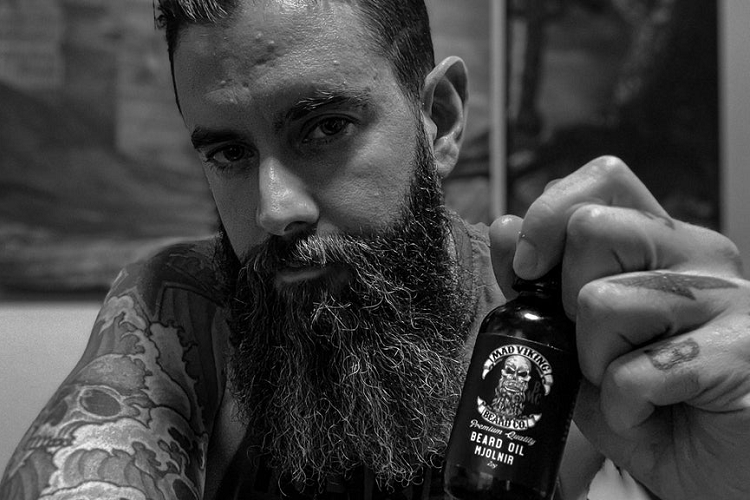Grooming a beard is no simple task. Maintaining a healthy, well-groomed appearance requires knowledge, patience, and the right products. Among these products, beard oil plays a pivotal role.
Immerse yourself in this comprehensive guide that explores the nuances of beard oil. Discover the art of selecting the perfect product, mastering the application technique, and finding the right balance of quantity and frequency.

Our aim is to empower you with the knowledge needed to maintain a beard that is not only visually appealing but also healthy and comfortable to wear.
What is Beard Oil?
Beard oil is a blend of carrier oils and essential oils specifically designed for the care and maintenance of beards. The carrier oils, such as jojoba, argan, or grapeseed oil, help to nourish and moisturize the beard hair, while the essential oils, such as cedarwood or peppermint, provide a pleasant scent and have additional benefits for the skin and hair.
Benefits of Beard Oil
- Moisturizes and Hydrates: The skin underneath your beard can often become dry and itchy, especially during the colder months. It helps to moisturize and hydrate the skin, preventing dryness and irritation.
- Softens and Tames Beard Hair: This oil helps to soften and tame unruly beard hair, making it easier to manage and style. This is especially beneficial for those with longer beards.
- Promotes Healthy Beard Growth: The nourishing properties of oil can help to promote healthy beard growth by providing essential vitamins and nutrients to the hair follicles.
- Prevents Beardruff: Just like dandruff on your scalp, beardruff is a common problem among men with beards. It helps to prevent beardruff by keeping the skin and hair moisturized.
- Adds Shine: A well-groomed beard should have a healthy shine to it. This oil helps to add shine to your beard, making it look well-maintained and healthy.
Choosing the Right Beard Oil
Choosing the right beard oil can be overwhelming with so many available options. Here are some factors to consider when selecting a oil:
- Ingredients: Always look for natural ingredients such as jojoba, argan, and coconut. These oils are known for their nourishing and hydrating properties.
- Scent: Consider your own preference when it comes to scent. Oils come in various fragrances, from subtle woodsy scents to more masculine and bold ones.
- Skin type: If you have sensitive skin, opt for an unscented or hypoallergenic oil to avoid irritation.
- Budget: Good quality oils can range from affordable to expensive. Set a budget and look for options that fit within your price range.
How to Apply Beard Oil
Now that you have chosen the best beard oil for your needs, it’s time to learn how to apply it correctly. Follow these steps for maximum effectiveness:
- Start with a clean, dry beard: Wash and dry your beard before applying any product. This will ensure that the oil penetrates the hair follicles and skin.
- Dispense a few drops of oil onto your palms: The amount of oil you need will depend on the length and thickness of your beard. Start with a small amount and adjust as needed.
- Rub your palms together: Evenly distribute the oil onto both hands before application.
- Apply the oil to your beard: Massage oil downward into your beard using your fingertips. Make sure to cover all areas, from the roots to the ends of your facial hair.
- Comb through for even distribution: You can use a beard comb or a brush to distribute the oil evenly and style your beard.
- Use daily for best results: Consistency is key when using this oil. Incorporate it into your daily routine for best results.
Frequency and Amount of Application
1. Recommended daily use for conditioning
Daily application of this oil is recommended for optimal beard health and aesthetics. After showering and patting your beard dry, apply oil to condition your hair and skin. This daily routine locks in moisture, reduces itchiness and gives your beard a shiny, well-groomed look.
2. Adjusting quantity based on season
The amount of oil you use can vary based on your beard’s size and the season. In drier months or climates, you may need to increase the amount of oil to counteract the lack of moisture in the environment. A rule is to start with a few drops and adjust based on how your skin and beard feel afterward.
3. Warning signs of using too much or too little
When using this oil, more isn’t always better. Over-application can leave your beard looking greasy and may clog pores, leading to skin irritation or breakouts. Signs that you’re using too much oil include an overly shiny beard and oily skin.
On the other hand, if your beard feels dry, brittle, or itchy, or if you notice dandruff, these could be signs that you’re just not using enough oil. Experiment with a set amount until you find what leaves your beard feeling soft, healthy, and manageable.
Mistakes to Avoid
1. Avoid Applying Before Proper Cleaning
Beard oil is most effective when applied to a clean, damp beard. Applying oil before washing your face and beard can trap dirt and bacteria close to your skin, potentially leading to breakouts or skin irritation.
2. Don’t Neglect the Skin Underneath
While the benefits of oil for your facial hair are undeniable, it’s also essential to massage the oil evenly into the skin beneath your beard. This helps to moisturize the skin, preventing dryness, itchiness, and beard dandruff. Apply the oil from the base of your beard, working it into your skin before distributing it through your hair.
3. Don’t Skip Regular Trims
Even if you’re trying to grow your beard, regular trims are essential for maintaining a healthy, well-groomed look. Trimming gets rid of the split ends that can cause your beard to become wiry or unruly.
And even when using this oil, some hairs may grow much faster than others, creating an uneven look. Regular trims will help maintain a uniform length and shape, contributing to your beard’s overall health and appearance.
Storing Beard Oils Properly
Beard oils, like most grooming products, have a shelf life and require proper storage to maintain their quality. Store your oil in a cool, dark area away from direct sunlight to prevent the degradation of the essential oils. Exposure to heat and light can cause the oils to oxidize, altering their scent, color, and beneficial properties.
When limiting air exposure, consider transferring your oil to smaller bottles if you’ve purchased it in bulk. Each time you open the bottle, the oil inside is exposed to oxygen, which can also hasten oxidation. By using smaller bottles, you limit the oil’s exposure to air, keeping it fresher for longer.
Most oils have an optimal shelf life of 1-2 years if unopened and stored properly. Once opened, aim to use your oil within 6-12 months. Signs that your oil has expired or oxidized include a rancid smell or changes in color and consistency. Remember, an expired product won’t provide the same benefits and could harm your skin or beard.
Conclusion
Beard oil is essential for any man looking to keep his facial hair healthy and well-groomed. With its numerous benefits and easy application process, there’s no reason not to add it to your grooming arsenal. Choose a quality oil that suits your needs and apply it regularly for maximum results.



